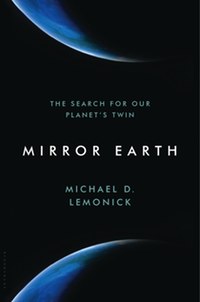Review: Mirror Earthby Jeff Foust
|
| Lemonick traces the history of exoplanet research through the work of many of the key people involved in searching for mirror Earths and other worlds—so-called “exoplaneteers.” |
In Mirror Earth, veteran science writer Michael Lemonick provides some useful perspective on the study of exoplanets. These efforts, he argues, are ultimately driven by a quest to find the world in the planet’s title: a planet with a size, composition, and orbit similar to our own—and thus would be a prime candidate for life. While exoplanet searches have turned up a menagerie of fascinating worlds unlike any in our own solar system, from “hot Jupiters” closely orbiting their stars to “super-Earths” bigger than our home world but not large enough to be gas or ice giants, what drives the field is the quest to find planets that, to first order, look a lot like our own.
Lemonick traces the history of exoplanet research through the work of many of the key people involved in searching for mirror Earths and other worlds. These “exoplaneteers”—a name some in the field use to describe themselves and their colleagues—typically came to exoplanet studies from other fields, some seeking a change in direction in their academic work, and others attracted by the initial wave of discoveries starting in the mid-1990s. Geoff Marcy, one of the most prolific exoplanet discovers, started his professional work studying magnetic fields of stars before deciding to tackle “a question I care about at a gut level,” the search for planets. Bill Borucki, the principal investigator for Kepler, got his start at NASA’s Ames Research Center in the 1960s developing heat shields for the space agency’s manned spacecraft; it was only much later did his career turn towards exoplanets and spearheading what became Kepler.
This focus on the people as much as the science—and there’s still plenty of science in this book, as Lemonick describes the discoveries of and state of knowledge regarding exoplanets—is a wise one. After all, it’s not the telescopes or spacecraft who discover exoplanets, it’s the people who develop the instruments, plan the observations, and reduce the data, seeking that tiny variation in spectral lines or the minute dimming of starlight that provides evidence that one or planets orbit that star. Lemonick also does a fine job painting vivid portraits of the exoplaneteers he profiles, tracing both their career paths and discoveries as well as what motivated them to pursue this field in the first place. Moreover, such an approach offers a longer shelf life for the book, so to speak, that simply chronicling the discoveries.
Of course, there are recent discoveries of interest that don’t make it into Mirror Earth, published in October. Those findings include the discovery of the closest known exoplanet to date, orbiting Alpha Centauri B; and the somewhat controversial discovery of five exoplanets orbiting another nearby star, Tau Ceti. That, though, is to be expected; indeed, there may be discoveries announced this week at the AAS meeting that put this review out of date! Those new discoveries, though, don’t invalidate the heart of this book: the quest to find Earth-like worlds around other stars, and the diverse, and growing, group of astronomers involved in that search.
